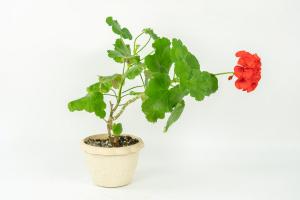What is the process by which plant roots absorb water?
Plant roots are essential structures that enable plants to absorb nutrients and water from their surroundings. Understanding the process by which roots absorb water is vital for the growth and health of plants. In this article, we will explore the process by which plant roots absorb water.
Root structure and function
Plant roots are made up of various parts that work collaboratively to absorb water and nutrients from the soil. The primary root, also known as the taproot, is the main root that emerges from the plant's stem. The secondary roots or lateral roots emerge from the primary root and spread outwards, branching out to form a dense network of roots.
The root hairs, which are small elongated structures, are responsible for water absorption. These root hairs increase the surface area of the root, enhancing the roots' ability to absorb water and nutrients from the soil. These structures are found in large concentrations close to the root tips, where the soil is most porous and water-rich.
The process of water absorption
The process of water absorption by plant roots involves several steps, including contact, adhesion, and absorption. The first step involves the root hairs making contact with water molecules in the soil. The root hairs' surface is hydrophilic, meaning it can attract and hold water molecules through hydrogen bonding.
The next step involves adhesion, where water molecules bind to the surface of the root hairs, creating a thin film of water around the root. The surface of the root hairs also releases compounds that promote adhesion, further enhancing their ability to hold onto the water.
The last step is absorption, where the water molecules are pulled into the root hairs' interior through osmosis. Osmosis is the movement of water molecules from an area of high concentration to an area of low concentration across a semipermeable membrane. In this case, the root hairs' membranes act as semipermeable membranes, allowing water molecules to pass through into the root's interior.
The role of transpiration
Transpiration is the process by which water is lost from the plant's leaves to the environment through evaporation. This process creates a tension or negative pressure within the plant's water-conducting tissues, known as the xylem. This tension pulls the water molecules upwards through the xylem, from the roots to the leaves, in a process known as the transpiration stream.
The transpiration stream also affects the water absorption process from the roots. The pressure gradient created by the transpiration stream draws water from the soil into the roots, maintaining a continuous flow of water throughout the plant. This process is known as the transpiration-cohesion-tension theory and is an essential component of water transport in plants.
Factors affecting water absorption by plants
The process of water absorption by plant roots can be affected by several factors, including soil moisture, root anatomy, and the presence of certain chemicals in the soil. Adequate soil moisture is necessary for water absorption, as dry soil can inhibit water uptake by the roots.
The root's anatomy also plays a vital role in water absorption. A root system with a dense network of roots and a higher concentration of root hairs can absorb water more efficiently than a root system with fewer roots or root hairs. Additionally, the presence of certain chemicals such as salt or fertilizer in the soil can also affect water absorption by inhibiting root growth or damaging the root hairs.
Conclusion
Plant roots absorb water through a complex process involving contact, adhesion, and absorption of water molecules. Root hairs play a crucial role in this process by increasing the surface area of the roots and promoting water molecule adhesion. Transpiration also plays a key role in maintaining the flow of water through the plant.
Understanding the factors that affect water absorption by plant roots can help growers optimize plant growth by providing the necessary nutrients and moisture to the plant's roots. Therefore, a comprehensive understanding of this process can significantly benefit crop production and agriculture practices.

 how many times do yo...
how many times do yo... how many planted tre...
how many planted tre... how many pine trees ...
how many pine trees ... how many pecan trees...
how many pecan trees... how many plants comp...
how many plants comp... how many plants can ...
how many plants can ... how many plants and ...
how many plants and ... how many pepper plan...
how many pepper plan...






























